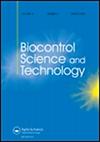Mesh covers on sentinel parasitoid traps prevent Drosophila suzukii movement and impact parasitism by Ganaspis brasiliensis and Pachycrepoideus vindemiae
IF 1.2
4区 农林科学
Q4 BIOTECHNOLOGY & APPLIED MICROBIOLOGY
引用次数: 0
Abstract
ABSTRACTParasitoids such as Ganaspis brasiliensis and Pachycrepoideus vindemiae are being researched for biological control of Drosophila suzukii, an important agricultural pest. Parasitoids can be monitored in the field by collecting infested fruit samples or using sentinel traps seeded with host larvae/pupae. Sentinel traps may be covered with a selective barrier to allow parasitoid movement, and prevent nontarget infestation and developing D. suzukii from exiting. In this study, two types of fabric mesh (‘square’ 1.1 × 1.1 mm2 and ‘oval’ 1.2 × 0.8 mm2) were assessed for restricting passage of D. suzukii, and enabling passage and parasitism by G. brasiliensis and P. vindemiae. Square wire meshes (1.04, 1.08, 1.11, 1.13, 1.18, and 1.53 mm2) were also tested as a durable alternative to the fabric mesh for G. brasiliensis sentinels. Both fabric meshes and the 1.08 and 1.13 mm2 square wire mesh prevented passage of D. suzukii. Passage was similar through fabric mesh for both parasitoids. For G. brasiliensis, parasitism was higher in open control sentinels than square mesh covered sentinels in one trial, but parasitism was similar at ∼40% in open and square mesh sentinels in another trial. The 1.04, 1.08 and 1.13 mm2 square wire mesh lowered G. brasiliensis parasitism. For P. vindemiae, parasitism was 2-fold higher in oval mesh than open sentinels which may be due to the mesh encouraging this wasp to forage longer. If a selective mesh must be used, the square fabric mesh prevented D. suzukii passage and resulted in the highest G. brasiliensis parasitism compared to wire meshes.KEYWORDS: Drosophila suzukiiGanapsis brasiliensisPachycrepoideus vindemiaespotted-wing Drosophilamonitoring AcknowledgementsThis work was supported by the USDA National Institute of Food and Agriculture Organic Research and Education Initiative under Grant 2022-51300-37890; USDA Agricultural Research Service (ARS) Areawide Pest management Program administered by Stephen Young (National Program Leader); and USDA ARS CRIS project #2072-22000-040-00D.Disclosure statementNo potential conflict of interest was reported by the author(s).Additional informationFundingThis work was supported by National Institute of Food and Agriculture: [Grant Number 2022-51300-37890]; Agricultural Research Service: [Grant Number 2072-22000-040-00D].哨点寄生蜂诱捕网罩可防止苏氏果蝇的移动,并对巴西赤眼蜂和巴西厚皮蝇的寄生产生影响
摘要研究了巴西Ganaspis brasiliensis和越南Pachycrepoideus vindeiae等拟寄生物对重要的农业害虫铃木果蝇的生物防治。可通过采集受寄生果实样本或使用装有寄主幼虫/蛹的哨点诱捕器在田间监测拟寄生蜂。哨兵陷阱可覆盖选择性屏障,允许寄生蜂移动,并防止非目标虫害和发展中的铃木氏夜蛾离开。本研究评价了两种织物网(“正方形”1.1 × 1.1 mm2和“椭圆形”1.2 × 0.8 mm2)对抑制猪腹扁虫传代、促进巴西扁虫和猪腹扁虫传代和寄生的作用。方丝网(1.04、1.08、1.11、1.13、1.18和1.53 mm2)也作为织物网的耐用替代品进行了试验。织物网和1.08和1.13平方毫米的丝网都阻止了铃木氏夜蛾的通过。两种寄生蜂通过织物网的通道相似。在一项试验中,开放对照哨兵的寄生率高于覆盖方形网的哨兵,但在另一项试验中,开放和方形网哨兵的寄生率相似,为40%。1.04、1.08和1.13 mm2平方的金属丝网降低了巴西蛾的寄生率。卵圆形网眼的寄生率比开放的哨兵网眼高2倍,这可能是由于网眼鼓励该黄蜂觅食更长时间。如果必须选用选择性网目,方布网目与金属丝网目相比,能有效地阻止铃木夜蛾的传代,且对巴西夜蛾的寄生率最高。本工作由美国农业部国家食品和农业有机研究与教育计划资助,资助项目为2022-51300-37890;美国农业部农业研究服务处(ARS)由Stephen Young(国家项目负责人)管理的区域有害生物管理项目;USDA ARS CRIS项目#2072-22000-040-00D。披露声明作者未报告潜在的利益冲突。本研究由美国国家粮食与农业研究所资助:[资助号:2022-51300-37890];农业研究服务处[资助号2072-22000-040-00D]。
本文章由计算机程序翻译,如有差异,请以英文原文为准。
求助全文
约1分钟内获得全文
求助全文
来源期刊
CiteScore
3.20
自引率
7.10%
发文量
64
审稿时长
4-8 weeks
期刊介绍:
Biocontrol Science and Technology presents original research and reviews in the fields of biological pest, disease and weed control. The journal covers the following areas:
Animal pest control by natural enemies
Biocontrol of plant diseases
Weed biocontrol
''Classical'' biocontrol
Augmentative releases of natural enemies
Quality control of beneficial organisms
Microbial pesticides
Properties of biocontrol agents, modes of actions and methods of application
Physiology and behaviour of biocontrol agents and their interaction with hosts
Pest and natural enemy dynamics, and simulation modelling
Genetic improvement of natural enemies including genetic manipulation
Natural enemy production, formulation, distribution and release methods
Environmental impact studies
Releases of selected and/or genetically manipulated organisms
Safety testing
The role of biocontrol methods in integrated crop protection
Conservation and enhancement of natural enemy populations
Effects of pesticides on biocontrol organisms
Biocontrol legislation and policy, registration and commercialization.

 求助内容:
求助内容: 应助结果提醒方式:
应助结果提醒方式:


